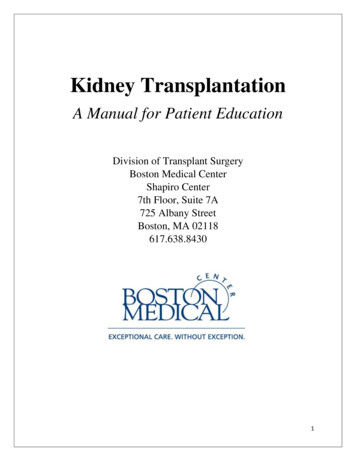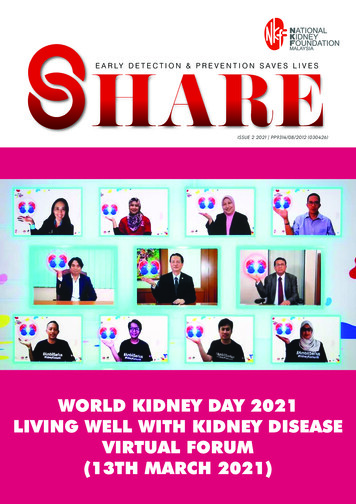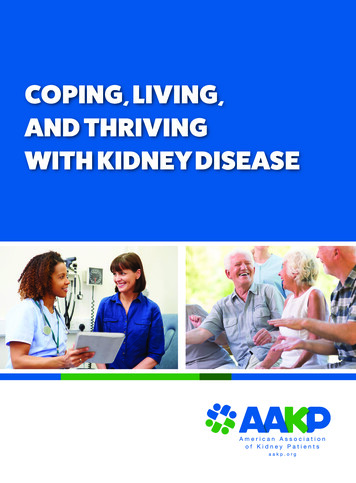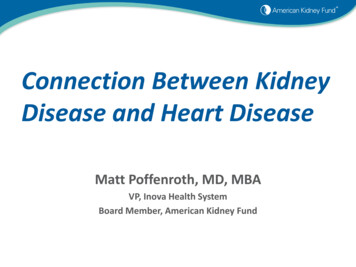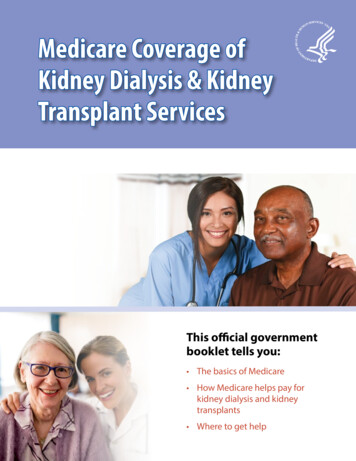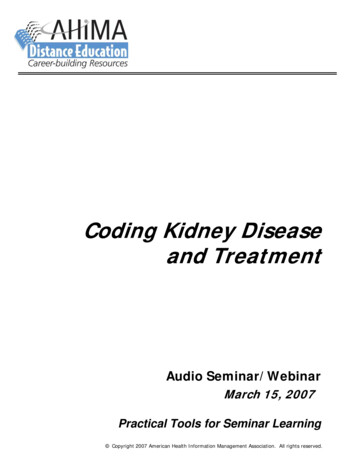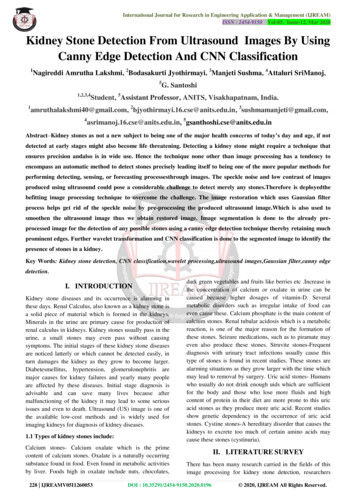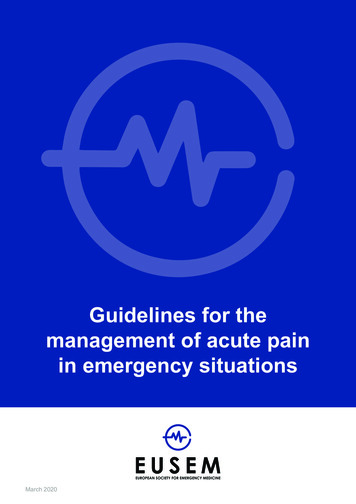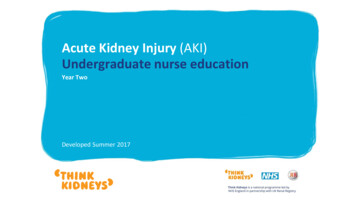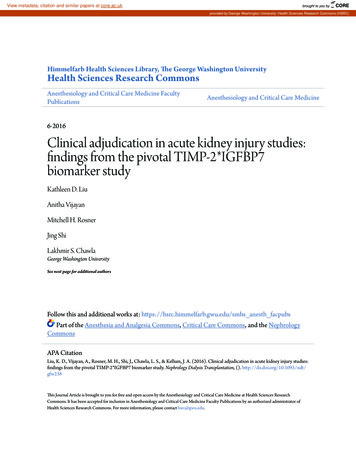
Transcription
View metadata, citation and similar papers at core.ac.ukbrought to you byCOREprovided by George Washington University: Health Sciences Research Commons (HSRC)Himmelfarb Health Sciences Library, The George Washington UniversityHealth Sciences Research CommonsAnesthesiology and Critical Care Medicine FacultyPublicationsAnesthesiology and Critical Care Medicine6-2016Clinical adjudication in acute kidney injury studies:findings from the pivotal TIMP-2*IGFBP7biomarker studyKathleen D. LiuAnitha VijayanMitchell H. RosnerJing ShiLakhmir S. ChawlaGeorge Washington UniversitySee next page for additional authorsFollow this and additional works at: https://hsrc.himmelfarb.gwu.edu/smhs anesth facpubsPart of the Anesthesia and Analgesia Commons, Critical Care Commons, and the NephrologyCommonsAPA CitationLiu, K. D., Vijayan, A., Rosner, M. H., Shi, J., Chawla, L. S., & Kellum, J. A. (2016). Clinical adjudication in acute kidney injury studies:findings from the pivotal TIMP-2*IGFBP7 biomarker study. Nephrology Dialysis Transplantation, (). http://dx.doi.org/10.1093/ndt/gfw238This Journal Article is brought to you for free and open access by the Anesthesiology and Critical Care Medicine at Health Sciences ResearchCommons. It has been accepted for inclusion in Anesthesiology and Critical Care Medicine Faculty Publications by an authorized administrator ofHealth Sciences Research Commons. For more information, please contact hsrc@gwu.edu.
AuthorsKathleen D. Liu, Anitha Vijayan, Mitchell H. Rosner, Jing Shi, Lakhmir S. Chawla, and John A. KellumThis journal article is available at Health Sciences Research Commons: https://hsrc.himmelfarb.gwu.edu/smhs anesth facpubs/154
NDT Advance Access published June 23, 2016Nephrol Dial Transplant (2016) 0: 1–6doi: 10.1093/ndt/gfw238Original ArticleClinical adjudication in acute kidney injury studies: findingsfrom the pivotal TIMP-2*IGFBP7 biomarker studyKathleen D. Liu1, Anitha Vijayan2, Mitchell H. Rosner3, Jing Shi4, Lakhmir S. Chawla5 and John A. Kellum61Division of Nephrology, Department of Medicine and Division of Critical Care Medicine, Department of Anesthesia, University of California,San Francisco, CA, USA, 2Division of Nephrology, Department of Medicine, Washington University, St Louis, MO, USA, 3Department ofof Intensive Care Medicine and Nephrology, Veterans Affairs Medical Center, Washington, DC, USA and 6Center for Critical Care Nephrology,Department of Critical Care Medicine, University of Pittsburgh, USACorrespondence and offprint requests to: John A. Kellum; E-mail: Kellumja@upmc.eduA B S T R AC TBackground. The NEPROCHECK test (Astute Medical, SanDiego, CA, USA) combines urinary tissue inhibitor of metalloproteinases-2 (TIMP-2) and insulin-like growth factor binding protein 7 (IGFBP7) to identify patients at high risk for acute kidneyinjury (AKI). In a US Food and Drug Administration registrationtrial (NCT01573962), AKI was determined by a three-memberclinical adjudication committee. The objectives were to examineagreement among adjudicators as well as between adjudicatorsand consensus criteria for AKI and to determine the relationshipof biomarker concentrations and adjudicator agreement.Methods. Subjects were classified as AKI 3/3, 2/3, 1/3 or 0/3 according to the proportion of adjudicators classifying the case asAKI. Subjects were classified as Kidney Disease: ImprovingGlobal Outcomes (KDIGO) AKI( ) when stage 2 or 3 AKI criteria were met.Results. Concordance between adjudicators and between adjudicators and KDIGO criteria were lower for AKI than non-AKIsubjects [78.9 versus 97.3% (P 0.001) and 91.5 versus 97.9%(P 0.01)]. Subjects who were AKI 3/3 or 2/3 but KDIGO AKI( )had higher median [TIMP-2] [IGFBP7] compared with those whowere AKI-1/3 or 0/3 but KDIGO AKI( ) {2.78 [interquartilerange (IQR) 2.33–3.56] versus 0.52 [IQR 0.26–1.64]; P 0.008}.[TIMP-2] [IGFBP7] levels were highest in patients with AKI 3/3and lowest in AKI 0/3, whereas AKI 2/3 and 1/3 exhibited intermediate values. The Author 2016. Published by Oxford University Press on behalf of ERAEDTA. This is an Open Access article distributed under the terms of the CreativeCommons Attribution Non-Commercial License (http://creativecommons.org/licenses/by-nc/4.0/), which permits non-commercial re-use, distribution, andreproduction in any medium, provided the original work is properly cited. Forcommercial re-use, please contact journals.permissions@oup.comConclusions. In this analysis, urine [TIMP-2] [IGFBP7] levelscorrelated to clinically adjudicated AKI better than to KDIGOcriteria. Furthermore, in difficult cases where adjudicators overruled KDIGO criteria, the biomarker test discriminated well.This study highlights the importance of clinical adjudicationof AKI for biomarker studies and lends further support forthe value of urine [TIMP-2] [IGFBP7].Keywords: acute kidney injury, biomarkers, diagnosis, insulinlike growth factor binding protein 7, tissue inhibitor of metalloproteinases-2INTRODUCTIONAcute kidney injury (AKI) is common among hospitalized patients and is associated with significant morbidity and mortality[1, 2]. At present, there are no therapies specific for AKI, andcare of patients with AKI is mainly supportive [3]. Consequently, early identification of AKI is thought to be critical because itallows for prompt implementation of best practices, includingreevaluation of drug dosing, nephrotoxin avoidance, close attention to fluid balance and other potential therapeutic maneuvers. In some cases it has been suggested that interventions (e.g.transfer to the intensive care unit or placement of a line for dialysis) should be considered based on the presence or absenceof moderate–severe AKI [4]. Ultimately, if patients at highrisk of AKI can be reliably identified, this may allow for clinicaltrials of novel therapies designed to reduce the severity or duration of AKI [5]. Along the same lines, if earlier detection ofrenal injury or identification of those at risk was feasible, then1Downloaded from http://ndt.oxfordjournals.org/ at GWU on June 28, 2016Medicine, University of Virginia, Charlottesville, VA, USA, 4Statistics, Walker Bioscience, Carlsbad, CA, USA, 5Department of Medicine, Divisions
ORIGINAL ARTICLEM AT E R I A L S A N D M E T H O D SPatients and proceduresThe methods and results of the Topaz trial have been reportedpreviously [6]. Briefly, this was a prospective observational study of420 critically ill adult patients enrolled within 24 h of admission toan intensive care unit (ICU) at 23 participating sites in the USAfrom May through December 2012. Paired serum and urinesamples for analysis of serum creatinine and urinary [TIMP-2] [IGFBP7] were obtained immediately upon enrollment and thenstored frozen until analysis. The primary endpoint was the diagnosis of AKI within 12 h of enrollment adjudicated by a clinical adjudication committee. Urine samples were analyzed for TIMP-2and IGFBP7 by technicians blinded to clinical data using a clinicalimmunoassay (NEPHROCHECK Test and ASTUTE140 Meter,Astute Medical) at three independent hospital laboratories. Thetest instrument automatically multiplied the concentrations ofthe two biomarkers together and divided this product by 1000to report a single numerical test result with units of (ng/mL)2/1000 (the units for all [TIMP-2] [IGFBP7] tests and cutoff valuesin this report). The median of the [TIMP-2] [IGFBP7] test resultsfrom the three laboratories was used for analysis.Adjudication processThe procedures for adjudication were defined in advance of thestudy. Specifically, the three adjudicators were all board-certified2nephrologists with clinical expertise in AKI who determinedas a group which variables would be provided to them for adjudication. Importantly, all adjudicators were unaware of the[TIMP-2] [IGFBP7] values throughout the adjudication process. After a round of practice adjudication, the adjudicatorsmet by teleconference to review the approach to the clinicaldata review and revisions were made. Variables included allserum creatinine values for up to 6 months prior to and 72 hafter enrollment, all hourly urine output data available for upto 24 h prior to and 72 h after enrollment, daily fluid balanceuse of diuretics and baseline demographic data includingweight, age and clinical setting. However, results of urine microscopy or ultrasonography were not available to adjudicators.AKI was defined according to the KDIGO consensus criteria [4]as a doubling of serum creatinine from baseline or urine output 0.5 cm3/kg/h 12 h (Stage 2 or 3 AKI). The adjudicators wereasked to determine whether AKI was present or absent (definedas ‘AKI’ or ‘no AKI’, respectively) within the 12 h after enrollment and sample collection based on these criteria.Adjudicators were encouraged to use their expert judgmentfor each case. For example, an adjudicator could diagnose AKIin a patient who died prior to reaching KDIGO criteria or whoreceived large volume resuscitation such that creatinine wasjudged to be less reliable. Conversely, an adjudicator mightjudge that AKI was not present even though creatinine orurine output criteria were met if extenuating circumstanceswere present. For example, if urine output criteria were onlytransiently met (for an hour) and then followed by a periodof brisk urine output after diuretics, an adjudicator mightjudge that AKI was not present. Adjudicators indicated theirdiagnosis (‘AKI’ or ‘no AKI’) independently without consultation with each other and were blinded to biomarker results.For the current analysis we classified subjects as AKI 3/3, 2/3,1/3 or 0/3 according to the proportion of adjudicators diagnosing each case as AKI. In other words, if all three adjudicatorsdiagnosed a subject as having AKI, the subject was classifiedas AKI 3/3. If only one adjudicator diagnosed the subject ashaving AKI while the other two indicated no AKI, we classifiedthis as AKI 1/3. Adjudicators were required to classify all casesas AKI or no AKI. For the purposes of the Topaz trial, a twothirds majority was predefined for use as the final diagnosis, sosubjects who were either AKI 2/3 or 3/3 were considered to haveAKI. We also determined whether subjects were KDIGO AKI( )or ( ) when either Stage 2 or 3 criteria were met or not, respectively, by serum creatinine or urine output using a computer algorithm without any adjudicator input.Statistical analysisThe association between rater concordance and AKI statuswas tested using the Fisher exact test. Fleiss’ kappa was used toassess the reliability of agreement between the three clinical adjudicators. Levels of [TIMP-2] [IGFBP7] were compared inthose subjects where there was discordance between the clinicaladjudication committee and the KDIGO criteria using the Wilcoxon rank sum test. Subjects were then grouped based on thepresence or absence of AKI based on the clinical adjudicationcommittee review and on whether or not there was concordancebetween all three reviewers, and levels of [TIMP-2] [IGFBP7]K.D. Liu et al.Downloaded from http://ndt.oxfordjournals.org/ at GWU on June 28, 2016best practice interventions could be implemented sooner, andpotentially improve outcomes.The NEPHROCHECK test (Astute Medical, San Diego, CA,USA) was recently approved by the US Food and Drug Administration (FDA) as the first test to identify patients at high riskof developing AKI [6, 7]. This test measures urinary tissue inhibitor of metalloproteinases-2 (TIMP-2) and insulin-likegrowth factor binding protein 7 (IGFBP7) [8]. Elevated urinary[TIMP-2] [IGFBP7] predicts an increased risk of moderate–severe AKI over the next 12 h; patients with values 0.3 (ng/mL)2/1000 have a 7-fold increased risk of AKI [95% confidenceinterval (CI) 4–22] compared to those with lower levels [6].Standardized, validated criteria exist for AKI. The KidneyDisease: Improving Global Outcomes (KDIGO) clinical practice guideline on AKI endorsed the use of modified Risk, Injury,and Failure; and Loss; and End-stage renal disease (RIFLE)criteria proposed by the AKI Network (AKIN) with minor modifications to include pediatric RIFLE for children [4, 9, 10]. However, despite well-established consensus criteria, AKI remains aclinical diagnosis [4]. Consequently, as part of the FDA registration process for the Nephrocheck test, a panel of nephrologistswith expertise in AKI were convened to adjudicate AKI, ratherthan relying only on consensus criteria. To the best of our knowledge, this is the first time that AKI has been formally adjudicatedin an FDA registration trial. The goal of the current study is todescribe the adjudication process, to examine the relationshipof [TIMP-2] [IGFBP7] values to AKI as defined by clinical adjudication both when the determination was unanimous andwhen it was not and to examine biomarker results when clinicaladjudication departed from consensus criteria.
were compared using the Kruskal–Wallis test and Jonckheere–Terpstra trend test. To compare the correlations between[TIMP-2] [IGFBP7] and clinically adjudicated or KDIGOAKI, the difference in two paired Somer’s D rank correlationswas calculated using levels of [TIMP-2] [IGFBP7] as the responsevariable and clinically adjudicated and KDIGO AKI as the two predictors. Finally, all P-values were two-sided and a P-value 0.05 wasconsidered statistically significant. Stata/SE 12.1 (StataCorp, CollegeStation, TX, USA) or R 3.1.0 (R Project for Statistical Computing,Vienna, Austria) were used for all analyses.R E S U LT SNo 384915243377140897.3%78.9%94.1%DISCUSSIONTo have concordance, all three members of the clinical adjudication committee had toagree on the diagnosis.To our knowledge this is the first study to examine the relationships between a biomarker and agreement between members ofTable 2. Interreviewer reliability between the three clinical adjudication committee members and the majority opinionMember 1Member 2Member 3MajorityMember 1Member 2Member 3Majority10.84 (0.77–0.91)0.84 (0.76–0.91)0.89 (0.83–0.95)10.90 (0.85–0.96)0.95 (0.91–0.99)10.95 (0.91–0.99)1Results are presented as reliability (95% CI).Table 3. Proportion of subjects with AKI based on clinical adjudication (CAC) versus the KDIGO AKI consensus criteriaKDIGOCACNo AKI (1/3 or 0/3)AKI (2/3 or 3/3)Total( )( )TotalAgreement330 (80.9%)6 (1.5%)336 (82.4%)7 (1.7%)65 (15.9%)72 (17.6%)337 (82.6%)71 (17.4%)408 (100%)97.9%91.5%96.8%For the purposes of this study, those with KDIGO Stage 1 AKI were not considered to have AKI. Agreement was present if the clinical adjudication committee adjudicated that AKI was notpresent and the maximum KDIGO stage was 0 or 1 or if the clinical adjudication committee adjudicated that AKI was present and the maximum KDIGO stage was 2 or 3.Clinical adjudication of AKI3ORIGINAL ARTICLETable 1. Concordance between the clinical adjudication committeemembers, stratified by the presence or absence of AKIDownloaded from http://ndt.oxfordjournals.org/ at GWU on June 28, 2016Of 408 subjects enrolled with clinical data available, 71 had AKI(56 AKI 3/3 and 15 AKI 2/3) and 337 did not (9 AKI 1/3 and328 AKI 0/3) based on the clinical adjudication committee review. There was complete agreement between the three clinicaladjudicators (AKI 3/3 or 0/3) in 94.1% of cases. However, concordance of all three reviewers was lower for AKI than for noAKI (78.9 versus 97.3%; P 0.001; Table 1). Interreviewer reliability ranged from 0.84 to 0.95 (Table 2), indicating excellentagreement. Overall, Fleiss’ kappa was 0.86 (95% CI 0.80–0.92;P 0.001) for all three adjudicators.When KDIGO AKI criteria were applied, 72 patients were ( )and 336 patients were ( ). Agreement between the clinical adjudication committee and the KDIGO criteria was 96.8% overall.Similar to the concordance between clinical reviewers, agreementbetween the clinical adjudication committee and the KDIGOcriteria was lower for AKI than for no AKI (91.5 versus 97.9%;P 0.01; Table 3); seven patients were KDIGO AKI( ) but didnot have AKI by clinical adjudication and six were KDIGOAKI( ) but had AKI based on the majority opinion of the clinical adjudicators (AKI 3/3 or 2/3). Furthermore, for these 13 patients where there was not agreement between the clinicaladjudication committee and the KDIGO criteria, concordanceof all three clinical adjudicators was much lower than for thosewhere there was agreement (38.5 versus 95.9%; P 0.001).We next examined urine [TIMP-2] [IGFBP7] in the 13 caseswhere clinical adjudication differed from KDIGO. As shown inFigure 1, the median [TIMP-2] [IGFBP7] levels were lower inKDIGO AKI( ) patients without AKI by clinical adjudication[0.52 (IQR 0.26–1.64)] compared with KDIGO AKI( ) patients who had AKI according to the clinical adjudication committee [2.78 (IQR 2.33–3.56), P 0.008]. Clinically adjudicatedAKI correlated more closely with [TIMP-2] [IGFBP7] than didKDIGO AKI (P 0.007), as determined by Somer’s D rankcorrelation.Finally, [TIMP-2] [IGFBP7] levels were compared betweenthe four groups: AKI 3/3, 2/3, 1/3 and 0/3. As shown in Figure 2,the lowest [TIMP-2] [IGFBP7] levels were observed in AKI 0/3patients, while AKI 3/3 displayed the highest values [0.32 (IQR0.16–0.83) versus 1.68 (0.80–2.87), P 0.001]. Discordanceamong adjudicators (AKI 1/3 and 2/3) was observed with intermediate [TIMP-2] [IGFBP7] values [0.52 (IQR 0.31–0.99) and1.13 (0.47–2.27)]. Overall we observed increasing median[TIMP-2] [IGFBP7] values from AKI 0/3 to 3/3 (P 0.001 foroverall trend). Similarly, when we examined the proportion of individuals in each of the four groups who had levels above the twocutpoints in clinical use (0.3 and 2.0), we observed an overall trendtoward a greater number of people above the cutpoint as AKI status went from 0/3 to 3/3 (P 0.001 for overall trend; Figure 3).
discordance between the clinical adjudication committee (CAC) andthe KDIGO criteria. Box and whiskers show IQRs and total observedranges (censored by 1.5 times the box range), respectively. Seven caseswere adjudicated as not AKI (AKI 0/3 or 1/3) but were KDIGO AKI( ),while six cases were adjudicated as AKI (AKI 2/3 or 3/3) but wereKDIGO AKI( ). In cases of discordance between CAC adjudicationand KDIGO criteria, patients adjudicated as AKI by the CAC hadsignificantly higher levels of [TIMP-2] [IGFBP7] than patients adjudicated as no AKI (P 0.008).a clinical adjudication committee and between the majority adjudicator opinion and KDIGO criteria for AKI. Our results arenotable first because they demonstrate the importance of clinical adjudication in clinical studies of AKI. While our clinicaladjudicators generally agreed with KDIGO, nearly 10% of thesubjects judged to have AKI by the adjudicators were KDIGOAKI( ) and in these KDIGO AKI( )/adjudicator AKI( )cases, urinary [TIMP-2] [IGFBP7] was always elevated, establishing a clear ‘biologic signal’. While our study only used datafrom an observational study, the results suggest that AKI interventional trials should be adjudicated as well since a substantialnumber of clinically relevant AKI cases may be missed withsolely KDIGO criteria. Second, these results provide further evidence for the utility of urinary [TIMP-2] [IGFBP7]. Even incases where experts disagree with one another or withKDIGO criteria, the biomarker test provides further information. This is important because these are precisely the kindsof cases where biomarkers are needed most—both for clinicalpractice and for clinical studies [7]. For example, two cliniciansmay differ on whether AKI is present or not, and in these cases,biomarkers can provide incremental information to help solidify the diagnosis.Of note, [TIMP-2] [IGFBP7] is not a diagnostic test forAKI, but rather a ‘risk assessment’ test that identifies individuals at increased risk for AKI over the next 12 h. Higher levelsportend greater risk for AKI [6] and for adverse long-term outcomes [11]. Consequently, we also sought to better understandthe relationship of [TIMP-2] [IGFBP7] and AKI, as identifiedby a committee of experts. Our hypothesis was that when4F I G U R E 2 : [TIMP-2] [IGFBP7] levels by the proportion of adju-dicators classifying each case as AKI. Box and whiskers show IQRs andtotal observed ranges (censored by 1.5 times the box range), respectively. [TIMP-2] [IGFBP7] levels increased from AKI 0/3 to AKI 3/3(P 0.001 for test of trend).experts agree, biomarker discrimination will be maximized.Our results bear this out.We showed that agreement between the three members ofthe clinical adjudication committee was excellent, but not100%. Not surprisingly, agreement was greater for non-AKIthan for AKI. A review of study charts where there was discordance between reviewers (AKI 1/3 and 2/3) suggestedthat in those cases, subjects often met AKI criteria for a veryshort period of time early within the 12 h risk assessment window, just missed meeting urine output criteria for AKI becauseof transient brisk urine output or were obese ( 150 kg), sourine output normalized to weight may have been variably interpreted by adjudicators. It should be noted that the adjudicator training required to achieve excellent consensus betweenthree expert nephrologists was relatively straightforward andshould be replicable in future clinical studies. Adjudicatorsunderwent training that was composed of two teleconferences,with a round of practice cases that were reviewed and discussed on the second call. During the clinical trial, adjudicators had the clinical trial protocol and the training slidesavailable as references.Our review of the small number of KDIGO AKI( ), clinically adjudicated non-AKI (AKI 0/3 or 1/3) subjects revealedthat KDIGO AKI( ) non-AKI was identified when subjectsmet AKI criteria for a very short period of time early withinthe risk assessment window or when the serum creatininewas falling but more than double the premorbid baseline. Insuch cases, the clinical adjudication committee determinedthat those patients did not have clinical AKI within the risk assessment window, yet the patients technically met KDIGOStage 2–3 criteria.Major strengths of our study include blinding of clinicaladjudicators to biomarker measurements as well as detailedK.D. Liu et al.Downloaded from http://ndt.oxfordjournals.org/ at GWU on June 28, 2016ORIGINAL ARTICLEF I G U R E 1 : [TIMP-2] [IGFBP7] levels in groups where there was
clinical data collected as part of the trial that allowed forhour-by-hour assessment of AKI. Limitations include the factthat we have not yet demonstrated that this approach can be extended beyond the three members of the clinical adjudicationcommittee. However, as previously stated, the approach waspredefined and training was standardized, so our approachshould be applicable to future studies as well.In sum, we examined agreement between three nephrologistsfor diagnosis of AKI in the context of a trial of novel biomarkersfocused on risk assessment for AKI. We demonstrated that withlimited training that can be easily accomplished, agreement wasexcellent, but not universal, and clinical adjudication did notalways agree with strict KDIGO criteria. Interestingly, biomarkerlevels were higher in those with clinically adjudicated AKI ratherthan those with AKI by consensus definition alone—in general[TIMP-2] [IGFBP7] results supported the majority opinion ofthe experts. Our results highlight the importance of clinicaladjudication committees in studies of AKI.AUTHOR CONTRIBUTIONSStudy concept and design: K.D.L., A.V., M.H.R., L.S.C., J.A.K.Acquisition of data: K.D.L., A.V., M.H.R., L.S.C., J.A.K. Analysis and interpretation of data: K.D.L., J.S., J.A.K. Drafting ofthe manuscript: K.D.L., J.A.K. Critical revision of the manuscript for important intellectual content: A.V., M.H.R., L.S.C.,J.A.K. Statistical analysis: J.S. Obtained funding: L.S.C., J.A.K.Study supervision: J.A.K.Clinical adjudication of AKIAC K N O W L E D G E M E N T SThe authors thank the investigators, staff and coordinators whoworked on the clinical trial, as well as the study participants. Thiswork was presented in abstract form at the American Society ofNephrology Kidney Week 2013.C O N F L I C T O F I N T E R E S T S TAT E M E N TK.D.L., A.V., M.H.R. were members of the clinical adjudicationcommittee and served as paid consultants to Astute Medical.J.S. has served as a paid consultant to Astute Medical. J.A.K.has received consulting fees and grant support from AstuteMedical as well as royalties from licensing fees for unrelatedtechnologies paid by Astute Medical to the University of Pittsburgh. L.S.C. has received consulting fees and grant supportfrom Astute Medical as well as royalties from licensing feesfor unrelated technologies paid by Astute Medical to GeorgeWashington University. The Topaz study was funded by AstuteMedical.REFERENCES1. Chertow GM, Burdick E, Honour M et al. Acute kidney injury, mortality,length of stay, and costs in hospitalized patients. J Am Soc Nephrol 2005; 16:3365–33705ORIGINAL ARTICLEFor both cutpoints there was a trend toward a higher proportion of individuals having [TIMP-2] [IGFBP7] levels above the cutpoint from AKI 0/3to AKI 3/3 (P 0.001 for test of trend).Downloaded from http://ndt.oxfordjournals.org/ at GWU on June 28, 2016F I G U R E 3 : Proportion of [TIMP-2] [IGFBP7] above the cutpoints of 0.3 and 2.0. Box and whiskers show proportion and 95% CI, respectively.
2. Hsu RK, McCulloch CE, Dudley RA et al. Temporal changes in incidence ofdialysis-requiring AKI. J Am Soc Nephrol 2013; 24: 37–423. Faubel S, Chawla LS, Chertow GM et al. Ongoing clinical trials in AKI. ClinJ Am Soc Nephrol 2012; 7: 861–8734. KDIGO Acute Kidney Injury Work Group. KDIGO clinical practice guideline for acute kidney injury. Kidney Int Suppl 2012; 2: 1–1385. Okusa MD, Molitoris BA, Palevsky PM et al. Design of clinical trials inacute kidney injury: a report from an NIDDK workshop—prevention trials.Clin J Am Soc Nephrol 2012; 7: 851–8556. Bihorac A, Chawla LS, Shaw AD et al. Validation of cell-cycle arrest biomarkers for acute kidney injury using clinical adjudication. Am J Respir CritCare Med 2014; 189: 932–9397. Kellum JA, Chawla LS. Cell-cycle arrest and acute kidney injury: the light andthe dark sides. Nephrol Dial Transplant 2016; 1: 16–228. Kashani K, Al-Khafaji A, Ardiles T et al. Discovery and validation of cell cyclearrest biomarkers in human acute kidney injury. Crit Care 2013; 17: R259. Mehta RL, Kellum JA, Shah SV et al. Acute Kidney Injury Network: report of aninitiative to improve outcomes in acute kidney injury. Crit Care 2007; 11: R3110. Bellomo R, Ronco C, Kellum J et al. Acute renal failure—definition,outcome measures, animal models, fluid therapy and informationtechnology needs: the Second International Consensus Conference of theAcute Dialysis Quality Initiative Group. Crit Care 2004; 8: R204–R21211. Koyner JL, Shaw AD, Chawla LS et al. Tissue inhibitor metalloproteinase-2(TIMP-2)·IGF-binding protein-7 (IGFBP7) levels are associated with adverse long-term outcomes in patients with AKI. J Am Soc Nephrol 2015;26: 1747–1754Received for publication: 8.1.2016; Accepted in revised form: 24.5.2016ORIGINAL ARTICLEDownloaded from http://ndt.oxfordjournals.org/ at GWU on June 28, 20166K.D. Liu et al.
6-2016 Clinical adjudication in acute kidney injury studies: findings from the pivotal TIMP-2*IGFBP7 . This Journal Article is brought to you for free and open access by the Anesthesiology and Critical Care Medicine at Health Sciences Research . were obtained immediately upon enrollment and then

